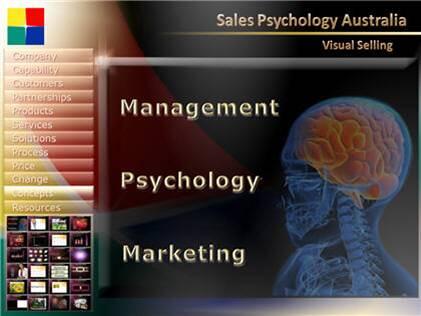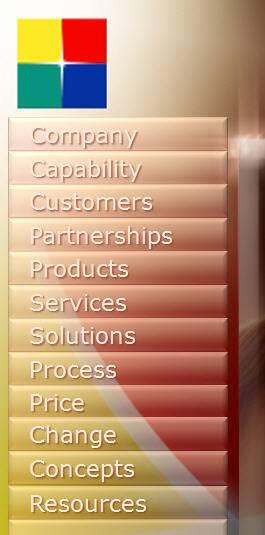Robert Lane and Andre Vlcek talk about approaches to selling better. They use PowerPoint as a tool to increase sales.
Author: Robert Lane and Andre Vlcek
Product/Version: PowerPoint
When It All Crumbles
A Different Approach
A prospective customer has invited you to showcase your company’s products and services, and the stakes are high. This contract could be huge. Your marketing department and executives have been fretting over the necessary PowerPoint slides for weeks. Every word has to be perfect. Every slide must be in exactly the right order. Your mission is to lay down a faultlessly planned and executed sales strategy that persuades this customer to buy exclusively from you … but you are worried!
 Robert Lane is a US-based presentation consultant specializing in visually interactive communication theory and is the author of Relational Presentation, a Visually Interactive Approach. His website features free demonstration video clips, tutorials, guides, and other resources that further explain the concepts discussed in this article.
Robert Lane is a US-based presentation consultant specializing in visually interactive communication theory and is the author of Relational Presentation, a Visually Interactive Approach. His website features free demonstration video clips, tutorials, guides, and other resources that further explain the concepts discussed in this article.
 Andre Vlcek is an Australian-based sales consultant and Managing Director of Aspire Communications Australia. He and Robert are co-authoring the forthcoming book Selling Visually with PowerPoint.
Andre Vlcek is an Australian-based sales consultant and Managing Director of Aspire Communications Australia. He and Robert are co-authoring the forthcoming book Selling Visually with PowerPoint.
(Andre) As a sales consultant and trainer with Sales Psychology Australia, I help people better understand the sales process. But, of course, I also must sell my own services; so I make sales calls too. I used to go into these meetings like countless millions of other salespeople every day, sporting a carefully scripted PowerPoint deck that outlined all the wonderful miracles I could accomplish—one slide, after another slide, after another. Not anymore. I still heavily use PowerPoint, but my approach to customers has changed. Now, instead of waltzing in with my own fixed agenda about how the meeting should flow, I let the customer steer the conversation most of the time.
My presentation materials are engineered so that I have highly flexible access across all visual content, allowing instant tailoring to customer needs and interests, or any objections that might arise along the way. I’ll show you what that looks like in a moment. But first, let me share a story that illustrates why this kind of change was so important to me—and why it probably is important to you, too.
Sometime ago I arrived for a scheduled one-hour meeting with the human resources manager at one of Australia’s major petroleum companies. This was my first meaningful contact with them, the proverbial foot in the door. The plan was to discuss the firm’s sales recruitment process. Certainly, I had my detailed linear PowerPoint show in hand, for what was supposed to be an informal meeting with only this person—and I had thought a lot about what he needed to hear. As soon as I walked into his office, though, I sensed trouble brewing.
The room contained five people, instead of one, and my HR manager contact proceeded to enthusiastically introduce me to his ‘unexpected’ guests, including the general manager of sales, a psychologist HR consultant, the firm’s call center manager, and of all people … the CEO! His guests happened to hear about the meeting just that morning and were curious about individual issues related to their job responsibilities. All of a sudden, my simple, casual talk turned into a full-blown sales demonstration, addressing multiple competing interests and perspectives. Those careful, late-night preparations for this meeting subsequently evaporated into thin air.
Five minutes into the talk, the psychologist interjected that another meeting was coming up and he had just a few quick questions to ask. Of course, my canned slide show didn’t contain appropriate answers to his issues, or, in some cases, slides sat somewhere 30 transitions away. Other attendees soon asked questions, as well, and a discussion ensued. The GM of sales wanted to know to what extent previous projects had increased sales revenues. The HR manager hoped to explore the candidate testing process, and the call center lady was wondering how all this related to her call center environment. Over the next hour, most of my PowerPoint content sat worthless and unused before me because, I couldn’t properly adjust it to the rapidly changing situation.
Back(Robert) Andre didn’t get invited back for a second meeting with that particular company, nor did he get the contract. Maybe attendees felt the interview was disorganized, or they weren’t satisfied with the detail of answers given to their questions. Who knows? Andre walked away feeling frustrated and embarrassed. His knowledge and experience could have helped that company immensely, and he WAS highly organized for that meeting—or rather, for one that didn’t occur as expected.

Figure 1
(Andre) Annoyance with PowerPoint’s linear design eventually led me to look for alternative ways of presenting information. It was unacceptable that my reputation hinged upon how well I could foretell the future by lining up perfect slide sequences in advance. Surely I needed something other than PowerPoint, I thought, and then I happened across Robert’s Relational Presentation approach while reading another article. That was the solution I needed and eventually, Robert and I teamed up to develop an interactive PowerPoint-based selling process featured in the book titled Selling Visually with PowerPoint. Download Chapter 1 HERE.
(Robert) What Andre didn’t realize is that PowerPoint already contained all the tools necessary to be fully conversational with, and adaptive to, his customers. He simply needed a change of perspective and a new direction.

Figure 2
(Andre) We began modifying my sales content, using an organizational structure called Topical Navigation. In my case, with my branding, it turned out like the example in Figure 2, above. Categories of information appear along the left side of slides and individual topics within those categories display in the menu at the bottom-left. While working with customers, I now can move seamlessly between hundreds of slide options, in any order, at any time.

Figure 3
Having that kind of flexibility has been a lifesaver several times already. The other day, I scheduled another hour-long meeting with a major bank, to discuss improving prospecting skills for their nearly 200 mobile business bankers. I don’t know. Maybe I attract these things, but upon arriving at the establishment, I could see the buying team was visibly distracted and anxious. The Vice President of Sales then informed me that some kind of technical glitch had occurred within their operations and that he could spare only fifteen minutes for our meeting. My timeslot promptly diminished in size by 75% before my eyes! I had to cut right to the point and hit the highlights of my proposal, without appearing frazzled or disorganized in the process. These days I can do that, and it’s not nearly as difficult as I once thought.
(Robert) To enable that kind of radical spontaneity while presenting, Andre worked through a process called Information Architecture well in advance; he mapped out all the discussion points that might arise with different customers, under various circumstances, and then determined what content would be required to address those situations. He contemplated what he wanted to say … AND … everything his customers might be curious or excited about, afraid of, opposed to, find value with, or otherwise show interest in. He now enters sales calls with a kind of PowerPoint-based, visual database full of sales tools, available at his fingertips. While interacting with customers, he navigates to topics on demand, according to perceived relevance.
(Andre) I played with the organizational structure for a while and finally decided I needed 12 main categories, as shown in Figure 3, above. These areas are generic enough to span just about every business-to-business sales situation I can imagine. In fact, the methods are proving so helpful that I’ve begun coaching sales teams on how to apply similar strategies to their situations.
(Robert) I was so impressed with Andre’s thoughts on visually interactive sales techniques that I asked him to provide more detail about three of his categories in the space remaining below. Also, note that Aspire now offers a free pdf guide outlining all twelve Selling Visually categories. Request the guide HERE.
Back

Microsoft and the Office logo are trademarks or registered trademarks of Microsoft Corporation in the United States and/or other countries.